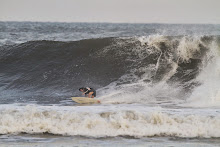
But tonight we don’t even start that. I get a phone call from the dive officer, Gerry Smith. There is a TSUNAMI warning for Catalina Island! We all remember the Indonesian tsunami in 2004. But this warning was for Catalina Island. And that’s where we are! Of course the predictions were for tiny 1-2 foot waves, but even a 2 foot rise in sea level over 15 min can create a nasty current.
So we ditched our dive and started playing with our data. We weren’t sure what to do with it. We threw out our early dives, in which we used bright lights and glow sticks that clearly inhibited initial pounce behavior. Then we just placed the dives on our Google map of the different zones. Each red dot represents a clean night dive presenting sea hares to lobsters. The white zone is preserve, the red zone non-preserve (this is just a rough draft).
Then we measured the distance of the dive from the nearest boundary (negative distance for outside, positive distance for inside the preserves), and plotted the proportion attacking as a function of that distance. This created the scattergram you see here.

What’s cool about this graph is that it shows that location matters. If you are clearly outside the preserve you see NO attacks. If you are way inside the preserve you see 30-35% of presentations eliciting attacks. If you are a little way inside the preserve you see just a few attacks.
a.) when the lobster season starts on Friday night? (We think we will get a huge influx of non-attackers)
b.) two months from now when there is very little immigration from outside the preserve (divers have either taken the lobsters or driven them out), and all the arrivals from October start getting hungry (We predict that in December a much higher proportion of remaining lobsters will attack).

No comments:
Post a Comment